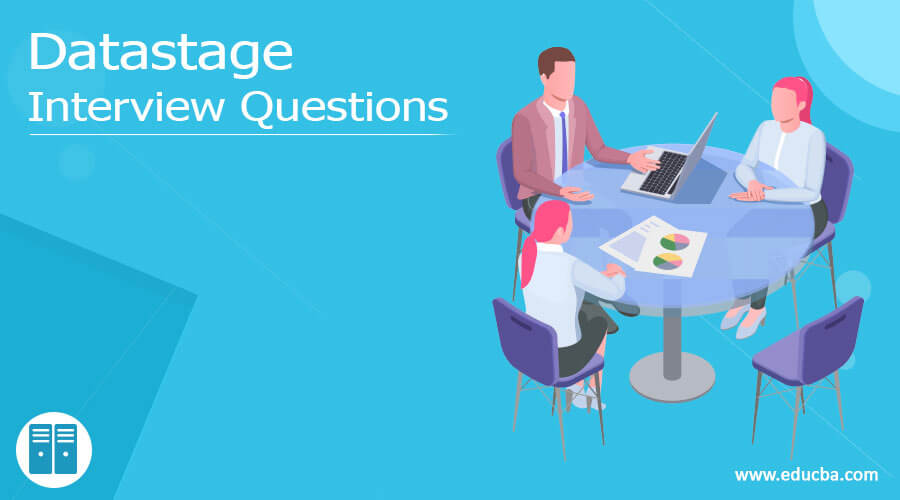Updated July 6, 2023
Introduction to Datastage Interview Questions
This is an outline of Datastage Interview Questions. DataStage (DS) is an ETL tool that can load data to any particular target after being extracted, transformed, and applied to business principles. Now we will be looking at a few questions and answers.
Datastage Interview Questions
Here we will discuss the top questions and answers.
1. What is Datastage?
Answer:
DataStage is a tool orchestrating jobs for Extraction, Transformation, and Loading (ETL). It is a very nice tool for data integration projects involving MDMs such as data warehouses, data marts, and system migrations.DataStage allows importing, exporting, creating, and managing metadata for use within jobs. It can even schedule, run and monitor jobs all within a workflow. And it also allows users to trigger multiprocessing jobs. GUI allows the Admin to Datastage development and execution environments.
2. What are the different Datastage Components?
Answer:
The core DataStage client applications are common in all versions of Datastage; those are:
Administrator – Administers DataStage projects and manages global settings and interactions with the system and environment variables.
Designer – Designers are used to creating DataStage jobs concerning job sequences which are later compiled into executable programs. It is the main module for developers to work on.
Director – manages running and monitoring DataStage jobs. Operators and testers mainly use it.
Manager – for managing, browsing and editing the data warehouse metadata repository.
3. How to add stages in Datastage Jobs?
Answer:
This procedure describes how to add stages to your job.
- In the Designer client palette area, click the File bar to open the file section of the palette.
- In the file section of the palette, select the Sequential File stage icon and drag the stage to your open job.
- Position the stage on the right side of the job window. In the file section of the palette, select another Sequential File stage icon and drag the stage to your open job. Position the stage on the left side of the job window.
- In the Designer client palette area, click the Processing bar to open the Processing section of the palette.
- In the processing section of the palette, select the Transformer stage icon and drag the stage to your open job. Position the stage between the two Sequential File stages.
- Select File > Save to save the job.
4. How to define your tables in Datastage?
Answer
When you save your column definitions as a table definition, the following naming rules apply:
1 Table names can be any length.
2 They must begin with an alphabetic character.
3 They can contain alphanumeric, period, and underscore characters.
5. How to define pre-configured stages in Datastage?
Answer:
There is a special feature that you can use to paste components into a shared container and add the shared container to the palette. This feature allows you to have pre-configured stages ready to drop into a job. To paste a stage into a new shared container, select Edit Paste Special Into new Shared Container. The Paste Special into the new Shared Container dialog box appears. This allows you to select a folder and name for the new shared container, enter a description and optionally add a shortcut to the palette. If you want to cut or copy metadata along with the stages, you should select the source and destination stages, automatically selecting links and associated metadata. These can then be cut or copied and pasted as a group.
6. How to rename a routine in Datastage?
Answer:
To rename an item, select it in the repository tree and do one of the following:
- Click the routine again. An edit box appears, and you can enter a different name or edit the existing one. Save the new name by pressing Enter or by clicking outside the edit box.
- Choose Rename from the shortcut menu. An edit box appears, and you can enter a different name or edit the existing one. Save the new name by pressing Enter or by clicking outside the edit box.
- Double-click the routine. The Mainframe Routine dialog box appears, and you can edit the Routine name field. Click Save, then Close.
7. How to configure Operational Metadata as a routine in Datastage?
Answer:
Suppose your mainframe job is going to generate operational metadata. In that case, you can specify the details of how the metadata will be handled on the Operational Metadata page of the Job Properties window. The Operational Metadata page has the following fields:
- Machine Profile. If you have already specified a machine profile that contains some or all of the required details, you can select it from the drop-down list, and the relevant fields will be automatically filled in.
- IP address. IP Host name/address for the machine running your program and generating the operational metadata.
- File exchange method. Choose between FTP and connect direct.
- User name. The user name for connecting to the machine.
- The password for connecting to the machine v XML file target directory and Dataset name for the XML file. Specify the target directory and dataset name for the XML file, which will record the operational metadata.
Conclusion – Datastage Interview Questions
In this article Datastage Interview Questions, we have seen the top questions and answers for any candidate to crackdown in an interview.
Recommended Article
This has been a guide to Datastage Interview Questions. Here we discuss the answers so that the candidate can easily crackdown on these Datastage Interview Questions. You may also look at the following articles to learn more –



